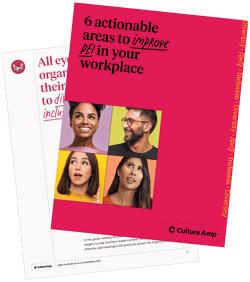
How to prioritize (and maintain) diversity in leadership

Diversity in leadership matters. Research from McKinsey found that companies in the top quartile of ethnic and cultural diversity on their executive teams are 36% more likely to experience above-average profitability when compared with companies in the fourth quartile.
Performance and the bottom line aside, your leadership team is also highly visible, both in and outside the organization. Your executives are the most likely to be featured on your website, and they’re also the ones that most people reach out to for speaking opportunities. They’re interacting with the media and the board. And - perhaps most importantly - your executives are the ones your internal employees look to for leadership.
To foster a truly inclusive culture, organizations need to ensure diversity among their leaders. After all, how can anybody reasonably believe that you prioritize diversity, equity, and inclusion (DEI) if your leadership team is entirely homogenous?
Despite the growing conversation about cultural diversity in leadership and the undeniable benefits diversity brings, many companies still struggle to get diverse professionals into those prominent roles.
In the same report, McKinsey found that over a third of companies in the data set had no women at all on their executive teams. Further, the representation of ethnic minorities was only 13%, even though non-white professionals make up 23% of the workforce in the U.S. A separate survey from Gartner discovered that nearly two-thirds of talent management leaders say 10% or less of their organization’s leaders and successors are women from diverse racial or ethnic backgrounds.
The numbers may be dismal, but many organizations are stepping up to the plate to attract and promote diverse candidates into leadership positions. Here are five ways these companies are prioritizing diversity in leadership.
1. Set a quantifiable goal
The merit of diversity metrics isn’t without debate, but the truth is that you can’t manage what you can’t measure.
To prioritize diversity in leadership, you need to set a quantifiable goal to keep your entire organization accountable and work toward better leadership representation. Several well-known companies have crafted leadership-focused diversity goals already, including:
- Airbnb: “20% of our Board of Directors and Executive Team, collectively, will be people of color by the end of 2021.”
- Pinterest: “By 2025, increasing the number of women in leadership by 20%.”
- Salesforce: “Double our U.S. representation of Black leaders and increase our representation of underrepresented minorities (Black, Latinx, Indigenous, and Multiracial) by 2023.”
To avoid having your diversity goals come off as lip service, don’t just make the target itself public. Provide regular updates (both internally and externally) about progress. You don’t want to make a bold promise and then fail to execute - something many companies have been criticized for doing.
Prioritizing diversity in leadership isn’t about public relations, feel-good metrics, or token hires. Rather, these goals give the organization something concrete and quantifiable to work toward as they continue their DEI journey.
2. Be mindful of unconscious bias
Unconscious bias often sneaks into the hiring process. It can start with your job descriptions and extend through your interviews.
Your organization’s entire hiring process says a lot about your company’s commitment to diversity, equity, and inclusion. A good way to begin is to ensure that job descriptions are as inclusive as possible. Here are a couple of things to keep an eye out for:
-
Requirements: The must-haves listed in your job description could be scaring diverse candidates away. Take, for instance, that women are 16% less likely than men to apply for a job after viewing it. Part of this can be explained by how men apply for jobs if they meet 60% of the requirements, whereas women only apply if they meet 100% of them. For that reason, ensure that you’ve narrowed down job requirements to the most important qualifications.
Do you really need a candidate to have a master’s degree, or will 15 years of experience suffice? Is it imperative that a candidate be able to drive themselves to work locations (which could rule out people with certain disabilities)? Or do you simply need them to be able to travel between locations (regardless of if they’re the ones driving)? -
Word choice: Words carry a surprising amount of weight in your job ads. Research shows that words like “assertive,” “dominate,” or even “strong” can make women reluctant to apply for certain roles. To truly emphasize the responsibilities of a leader or an executive, focus on impact instead of flowery language. It’s also important to pay attention to other language subtleties, like pronouns and gender identities.
For example, mentioning something like, “...lead the talented men and women of Company XYZ” in the job description excludes non-binary professionals, potentially discouraging people from that community from applying. Instead, consider the more inclusive: “...lead the talented people of Company XYZ.''
Beyond your job descriptions, put measures in place to ensure that unconscious bias isn’t preventing you from bringing in diverse candidates to interview. One study found that minorities who “whitened” their resumes by removing all references to race were twice as likely to be called in for interviews.
Removing all personal and identifying information - like name, gender, location, and more - will keep your hiring panel focused strictly on qualifications without making assumptions and judgments based on stereotypes and unconscious bias.
3. Work with executive recruiters who focus on DEI hiring
Achieving greater gender, racial, and cultural diversity in leadership at your organization can seem like an uphill battle, but you don’t need to go it alone. There are executive recruitment agencies that specialize in diverse hiring. These professionals have access to high-quality candidates, varied networks, and other tools and resources that you might not discover on your own.
To find a recruitment partner that can help you step up your diverse leadership hiring, you can:
- Ask for recommendations: It’s possible that you already know some other organizations that worked with an executive recruiter specializing in diversity. Ask your network if they have any recommendations. Similarly, if you’re connected with any DEI professionals - such as speakers, hiring managers, and other influencers - it’s worth asking if they can refer your organization to diversity-focused recruiting experts.
- Look on LinkedIn: LinkedIn can help you find qualified experts to partner with as you undergo your DEI efforts. Try searching profiles for terms like “DEI recruiter,” “diversity recruiter,” or “executive recruiter diversity.”
- Search Google: You might be surprised by how much a quick Google search for “diversity executive search firm” can reveal. You’ll find dozens of agencies and recruitment firms that could help you find top talent and increase the diversity of your leadership team.
4. Tap into diverse talent networks
It’s challenging to build a diverse team of executives if your entire pool of candidates lacks diversity. That speaks to the importance of connecting with a widely varied pool of talent.
This is another area where an executive recruiter can help you. However, there are also a number of organizations that you could partner with, including (but certainly not limited to):
- American Indigenous Business Leaders (AIBL)
- Corporate Women Directors International
- Executive Leadership Council (ELC)
- Hispanic Alliance for Career Enhancement (HACE)
- Out and Equal
- National Association of Asian American Professionals
Additionally, asking your existing employees to refer people from their networks to your open positions can help you get in front of an even wider array of qualified candidates. This tactic is particularly effective if you’re asking employees who identify as diverse professionals, or as somebody from an underrepresented background.
5. Provide advancement opportunities to employees
Nothing will undermine your commitment to diversity and inclusion faster than building a diverse team but failing to develop and promote all types of employees.
Unfortunately, many companies fall short of promoting and advancing employees from diverse backgrounds - especially when it comes to Black professionals. Research from McKinsey found that Black employees are 23% less likely to say they receive “a lot” or “quite a bit” of support to advance at work. They’re also 41% less likely to view promotions in their workplaces as fair.
One effective way to build a more diverse leadership team is to promote qualified and high-performing employees from within the organization. To ensure that opportunity truly is equal throughout your organization, you can take several steps, including:
- Detailing clear paths for advancement for all employees, as transparency is crucial for inclusivity.
- Encouraging regular and candid conversations about career goals.
- Providing learning and development opportunities to all employees, with diversity in mind. For example, if all of your workshops are led by straight, white men, that won’t feel relevant or inclusive to LGBTQ* and BIPOC employees.
These tips will help employees at all levels and backgrounds feel supported in their career growth, regardless of where they’re starting.
Make diversity in leadership a priority
When it comes to increasing diversity in leadership positions, it’s easy for companies to offer lip service about how they intend to build a more well-rounded executive team.
However, that’s nothing more than smoke and mirrors. Organizations that want to reap the benefits of diverse leaders (and there are plenty of benefits to be had) need to take smart and strategic steps to get more varied and qualified candidates into their executive pipeline - and eventually into the decision-making seats.
Diversity in leadership doesn’t just bring diverse perspectives (and ultimately more strategic decisions) to the organization. It also introduces an array of role models that employees of every background can relate to and look up to.





